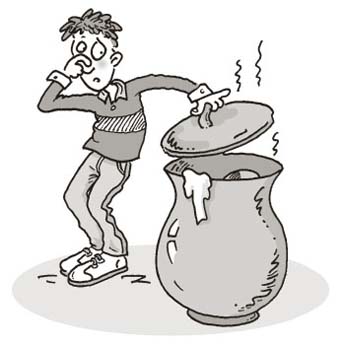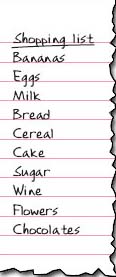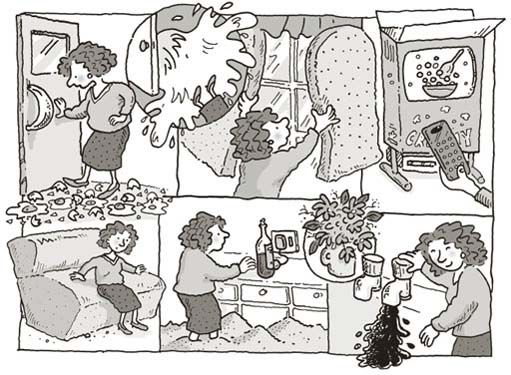3.2 Using mental images
As adults, we tend to do most of our thinking in words. However numerous experiments have been carried out that support the suggestion that we will remember verbal or written information better if we also form a mental image of the information. The mental image will give us another cue when we come to recall the information. In addition the effort we make in forming the image will help to fix it in our memory. This works best if the images we form are large colourful and bizarre as we tend to remember distinctive items rather than everyday items.
Using mental images when you first start to learn a new language has proved very effective for helping people grasp basic vocabulary. This is the key word technique. For example take the French word ‘poubelle’ (pronounced pooh-bell) which translates as ‘bin’ in English. The first step is to think of an English word or words that sound like the French word or part of the French word. This will give you your key word. Then you make a mental picture of the key word with the English translation. So in this example you could picture yourself lifting the lid off your bin which has turned into a bell and holding your nose because of the ‘pooh’.

This might sound complicated, but doing it is much simpler than describing it. It is very successful as well as being a lot less effort and more fun than learning lists of vocabulary by repeating the words over and over again.
Michael Raugh and Richard Atkinson (1975) developed this key word technique and carried out an experiment on two groups of participants. The participants were asked to learn a list of 60 Spanish words but only half of them were taught to use the key word technique. When they were tested later the participants using key words scored an average of 88 per cent compared to only 28 per cent for the participants who did not use key words.
This study by Raugh and Atkinson is a good example of a simple experiment. The experimenters had two groups of participants and they manipulated one difference between the two groups. The experimental group were taught to use key words and the control group were not. Both groups were then given a memory test. In experiments the thing that the experimenter manipulates is called the independent variable and the thing that the experimenter measures is called the dependent variable. When researchers design experiments they do need to consider whether any other factors or variables might be influencing their results. It is important that the experimenter tries to eliminate or control these variables.
Activity 3: Identifying variables
In the Raugh and Atkinson experiment can you identify the following variables?
the independent variable
the dependent variable
a variable that should be controlled.
Discussion
The independent variable is the variable that the experimenter manipulates so this is the instruction to use the key word technique.
The dependent variable is the variable that alters as a result of the manipulation of the independent variable. The experimenter measures this variable and it is the number of Spanish words recalled.
One variable that the experimenter might need to control is to make sure that none of the participants had learnt any Spanish before the experiment as this could affect their score on the memory test.
A number of mnemonics or memory strategies are based on using mental images. A mnemonic is a strategy for improving memory and you are probably familiar with several mnemonics such as the rhyme ‘30 days hath September, April, June and November, all the rest have 31 except February which has 28…’ or ‘Richard Of York Gave Battle In Vain’ to remember that the rainbow is made up of Red, Orange, Yellow, Green, Blue, Indigo and Violet.
An ancient mnemonic device called the ‘method of loci’ was developed by the poet Simonides who lived in Ancient Greece in the year 500 bc. This technique works by the learner linking mental images of the items they are trying to remember with a sequence of locations that they already know.
Activity 4: Method of loci
Let's take a simple example. Suppose you wanted to remember a list of ten items that you need to shop for.

You would imagine each of these items at various locations around your home or placed at different points down a street that you know well. Remember this technique works best if the images are outstanding and silly rather than sensible. I have suggested some images for our list in the passage below. Please read through the passage and take a moment to make the mental pictures but don't worry too much about trying to remember the items. However it is very important that you do make the picture in your mind.
Try to imagine your front door but with a huge banana instead of the usual handle. When you open the door and walk into the entrance the floor is covered in eggs and you have to walk over the eggs to get to the living room. Imagine the eggs cracking under your feet and the mess! Anyway it gets much messier because when you open the living room door you are almost knocked off your feet by the river of milk that comes gushing out. You stagger over to the window to pull the curtains which have turned into two giant slices of bread. You try to turn on the TV but fail because that has been replaced by a very large packet of cereal. Time to have a sit down, but when you collapse on the sofa you sink down into a sofa sized ginger cake. Go to the kitchen for a drink. Walking across the kitchen floor is a bit difficult as it is knee deep in sugar and when you have reached the kettle you find it has turned into a bottle of wine. I prefer white but you can visualise red if you want. Give up and go for a mug of water. Unfortunately when you reach down a mug from the cupboard it is filled with a bouquet of flowers and when you turn the tap on it is chocolate not water that comes out.

Discussion
Leave the shopping list now at least for an hour and in the meantime try not to keep checking whether you have remembered the items. You will probably find that an hour or so later you will be able to remember most of the items on the list. You will even find that a few days later you will still be able to recite most of the list.
This is a fairly trivial example and that most of us would just write our shopping list down. However hopefully it has demonstrated for you that making mental images can be a powerful aid to memory. The technique can be adapted for other more relevant situations. It has been tested on students revising for exams where it has been found to improve recall. For example if you had to take a psychology exam you could make up mental images of some of the research you have read about and arrange these images in a logical sequence around your home.
Using mental images to organise our thoughts can make our thinking and remembering much more efficient. However there are other organising principles which can also be useful such sorting information into categories.
